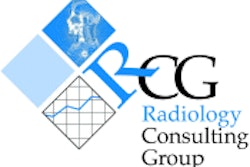CHICAGO - A new multislice CT scanner that collects 16 slices of data with a single rotation is among the highlights in the RSNA booth of Siemens Medical Solutions of Iselin, NJ. Called Somatom Sensation16, Siemens claims that the scanner provides up to 12 times the acquisition speed of existing four-slice scanners.
Sensation16 features a 0.4-second rotation time, an increase of 100 milliseconds over the company’s previous premium CT system, Somatom Volume Zoom. It also produces much thinner slices and isotropic resolution, with a voxel size of 0.5 x 0.5 x 0.6 mm, according to Markus Lusser, segment manager for CT. Users can acquire 72 mm of coverage per second with 1.5 mm slice thickness with no image quality problems, he said.
Sensation16 has FDA clearance, with the first system installed at the University of Erlangen in Germany. The first U.S. site will be installed in the next two months, with standard commercial deliveries beginning in July, Lusser said.
In MRI, Siemens is featuring its new Maestro upgrade for the company’s high-field Harmony, Symphony, and Sonata magnets. Maestro features a number of new software-based technologies that support faster scanning at higher resolutions, according to Juergen Heller, product manager of high-field MRI.
Inline technology refers to a Siemens technique that enables a Maestro-class scanner to conduct image post-processing during scanning and reconstruction. In addition, the system conducts motion-correction techniques and maximum intensity projection (MIP) reconstructions in the background while patients are being scanned, saving additional time, Heller said.
A new online display capability shows multiple image displays on a single screen, such as cine loops, thumbnail images, and ECG data. Meanwhile, the syngo Scan Assistant is a technique that tells Maestro users how changes to MRI sequences affect scan parameters such as scan time.
Other new features on Maestro include a new Sprint gradient package, a new parallel imaging technique called iPAT that reduces artifacts from patient movement, and 3D VIBE, a volume-interpolated breath-hold package.
Maestro is available as a software upgrade for all installed Harmony, Symphony, and Sonata systems, according to Heller. All new high-field Siemens scanners ship with Maestro as a standard feature, he said.
In PACS and IS developments, Siemens unveiled Soarian, a healthcare information system that serves as an enterprise workflow engine. Modeled after the firm's syngo software platform, Soarian's user interface accommodates the needs of individual users, according to Siemens. Embedded analytics allow users to monitor, measure, and act on information, according to the vendor.
Soarian Clinical Access is a clinical repository that is available at the point of care through the vendor's syngo modality consoles, workstations, and PACS network. A new version of MagicWeb includes a syngo user interface and fast image transmission, according to the vendor
Siemens also showed its Radiology Command Center, providing integration with its MagicView Mondo NT-based PACS workstation, Novius Radiology RIS, and Talk Technology's TalkStationRadiology speech recognition system.
Work-in-progress developments included a system logon capability via a fingerprint mouse, as well as a MagicWeb electronic tablet that offers wireless image and report display.
In ultrasound, the firm's new Antares premium ultrasound scanner took center stage. In work-in-progress developments, the company is showing tissue equalization technology, first used on its Acuson Sequoia scanner, ported to the Elegra platform.
Siemens has also migrated its 3D Express Ultra-Fast rendering technology to its gray-scale Adara scanner. The firm's Total Viewer multimodality viewing package highlighted enhancements to its KinetDx ultrasound PACS offering.
In the realm of women’s health, Siemens highlighted a new technology relationship with Hologic in which that Bedford, MA, vendor will supply amorphous selenium flat-panel detectors to be incorporated into Siemens mammography systems. A full-field digital mammography system based on the panels should be available in mid-2003.
In other women’s health developments, Siemens displayed its new Flex2 bi-directional flexible mammography paddle, as well as the company’s SoftSpeed variable compression feature. Siemens also highlighted a Hologic Delphi C bone densitometry system that it is selling through another deal with Hologic inked earlier this month, according to Joanne Scott-Santos, product manager for women’s health.
In nuclear medicine, Siemens highlighted Biograph, the company’s hybrid CT-PET scanner. The company has begun clinical installations of the system, which is new in operation at five sites worldwide. The scanner is available in both bismuth germanate (BGO) and lutetium oxyorthosilicate (LSO) configurations.
Other nuclear medicine highlights include Accel, an LSO PET camera that Siemens believes will make up 50% of the company’s PET shipments, and version 2.0 of the company’s eSoft nuclear medicine workstation. The new version now supports both image acquisition and processing, according to Barbara Franciose, vice president of the company’s nuclear medicine group.
Siemens x-ray highlights include a new Axiom angiography product line. Axiom Artis MP is a new multipurpose system, while Axiom Artis FA is designed for vascular, interventional, and surgical procedures. Axiom Artis BA is a single-plane version of Artis FA, designed for neurointerventional work. Meanwhile, Siremobil Iso-C 3D is a new 3-D surgical C-arm.
By Brian Casey and Erik L. Ridley
AuntMinnie.com staff writers
November 27, 2001
For the rest of our coverage of the 2001 RSNA meeting, go to our RADCast@RSNA 2001.
Copyright © 2001 AuntMinnie.com



















